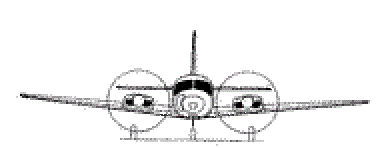Timothy wrote:
On what type(s)?
BE58, BE76 and DA42
Of course less ground clerance reduces the safety margin. Which is more of a consideration when training than in day do day operations.
Cobalt wrote:
Ground clearance getting a bit tight on the DA42 (looks like about half normal clearance). More worried about the wing tip here
I suspect a firm landing with that amount of wing down would get the prop and the wingtip (the main gear oleo will compress quite a bit in the event of a hard landing, reducing prop clearance further)
RobertL18C wrote:
Have not had an incident myself, gratefully, but am aware of incidents related to the PA-34 and PA-30. Quite a few MEPs are not that tolerant of side loads on the main gear, and can also think of main gear folding on the upwind gear. Obviously the absence of any crosswind technique will place unnecessary side load on the downwind leg.
The wing down technique is much less likely to put side loads on the gear than kicking off drift, because the former will always have the aircraft straight down the runway while the latter, if misjudged, can mean landing in any old directions.
Dave_Phillips wrote:
BE58, BE76 and DA42
Reports please!
We already have a great picture of a DA42, here is the BE58:
On neither of these does a propstrike seem possible.
Same is true of Seneca and C310:


It may be marginally possible on the Duchess:

But it’s a close run thing.
PA31 and PA23 are clearly impossible:


So, I’d love to see the reports showing this to be a common thing.
Incidentally, all those rotations are 17-22°, so roughly twice the maximum I have ever seen, and that was in extremis.
It would be a shame to put people off this technique without good cause (though absolutely right if there is good cause, of course!)
Don’t these images ignore oleo compression or any forward tilt the the aircraft?
Exactly what I was going to say.
When I had my prop strike in 2002, I worked out how it happened. The pothole was 5" deep, the nose oleo compression was 3", and guess what the prop clearance during normal taxi is? 8" 

I reckon those propeller arc diagrams are nominal, too.
There have been loads of double prop strike (small “ding”) reports on twins. Although obviously one cannot usually tell at which phase of the previous flight (or taxi) it happened, it is possible. I read a report somewhere of a Seneca a few months ago.
“Over 20 knots crosswind, land across runway” was in the POH of a CH701 that I used to fly. “Use all available runway width” is a more generally useful technique.
We rarely get strong winds in SW Scotland, but like Timothy and DP, I like to get the upwind wing down sooner rather than later in any approach to a defined runway, not least because it leaves me less to do during and after landing – when full into-wind aileron is needed.
I think any suggestion that a slip appreciably reduces stall speed, or that it may induce a spin, must be rather type-specific, at best.
Checking the last five years on the NTSB has quite a few hard landings, nose wheel landings and undershoots, but only one crosswind incident in Alaska in a PA-31. Landing technique was not discussed but the attempt was made with a 30-35 knot crosswind, the PA-31 demonstrated crosswind is only 20 knots.
I think that you can see from the PA31 geometry above that whatever happened to it, it was not caused by a wing down leading to a propstrike. The PA31 is the least likely of all to let this happen, as the wheel is as close to being directly below the crankshaft as it could be.
I am far from saying that crashes don’t happen in crosswinds, nor that MEPs can’t have propstrikes. Of course that would be ridiculous. What I am saying is that I am concerned that an OWT starts that using wingdown is more likely to cause a propstrike than kicking off drift. I simply don’t buy that.
I have seen my share, both as instructor and RHS passenger, of completely screwed up crosswind landings, getting close to complete loss of control and runway excursions. Not one of them has been following a wing down approach.
I would go further to suggest that on ice or snow, only wing down will work safely.
That’s actually why you make a transition from crab to low wing on short final …. at least I do.